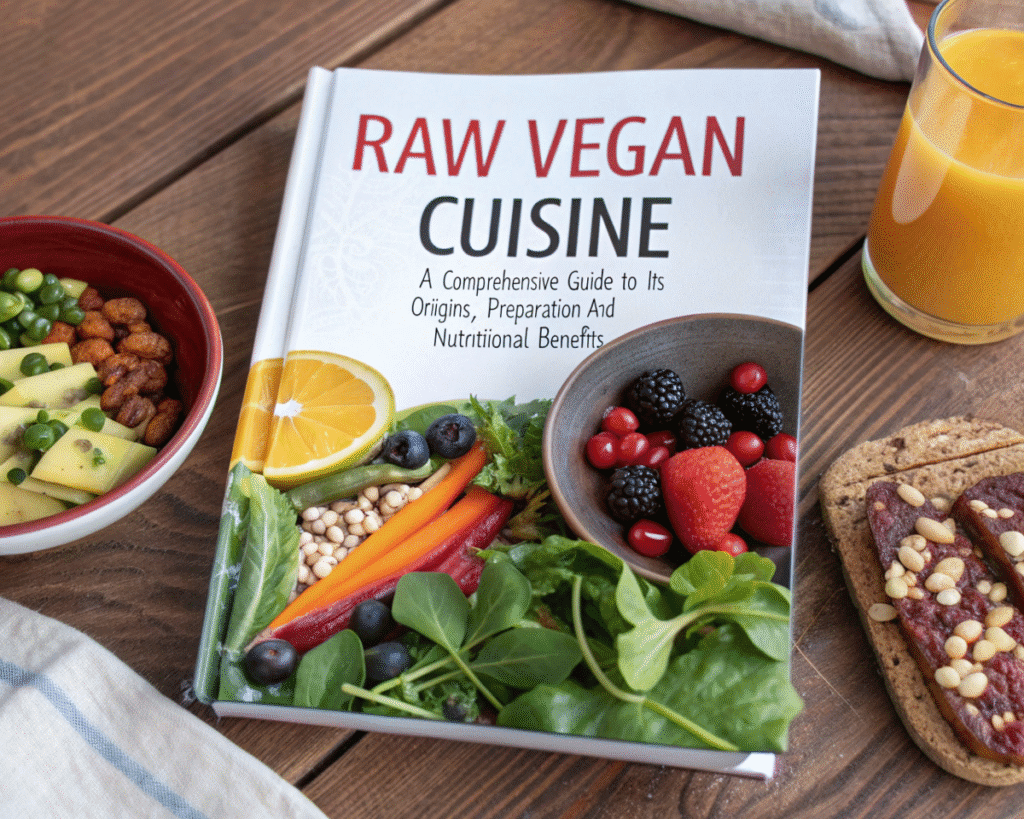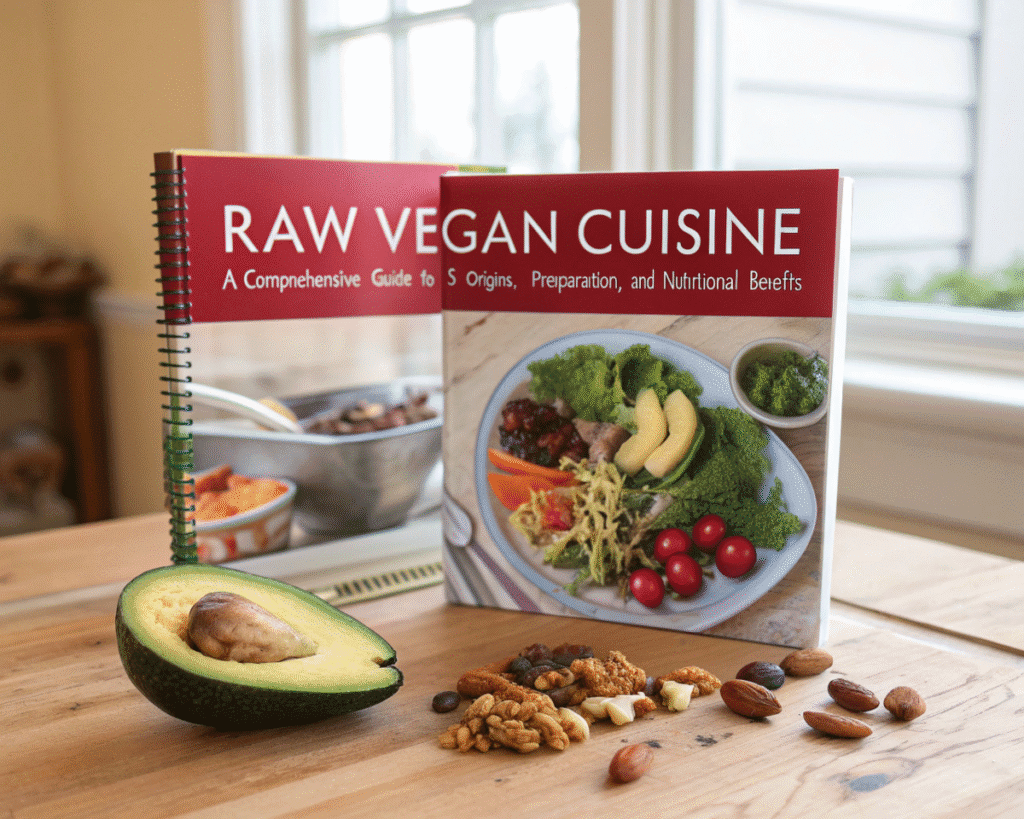
Raw vegan cuisine captivates food enthusiasts with its vibrant flavors, fresh ingredients, and health-focused approach. This plant-based eating style emphasizes unprocessed, uncooked foods, offering a unique culinary experience that prioritizes natural vitality. we explore what raw vegan cuisine is, its historical roots, how to prepare it, its nutritional benefits, and essential tips for adopting this lifestyle.
What Is Raw Vegan Cuisine?
Raw vegan cuisine consists of plant-based foods that remain unheated above 118°F (48°C). This temperature preserves enzymes, vitamins, and minerals believed to enhance health. Common ingredients include fruits, vegetables, nuts, seeds, sprouted grains, and herbs. Unlike traditional cooking, raw vegan methods use blending, dehydrating, soaking, and sprouting to create dishes like smoothies, salads, zoodles, and raw desserts.
This cuisine avoids animal products, processed foods, and high-temperature cooking, focusing on whole, organic ingredients. It appeals to those seeking health benefits, environmental sustainability, or ethical eating practices. Raw vegan cuisine celebrates creativity, transforming simple ingredients into nutrient-packed meals.
The Origins of Raw Vegan Cuisine
Raw vegan cuisine traces its roots to early 20th-century health movements, though humans consumed raw plant foods long before cooking methods emerged. The modern raw food movement gained traction in the 1970s, influenced by pioneers like Ann Wigmore, who founded the Hippocrates Health Institute. Wigmore promoted raw, living foods to detoxify the body and boost vitality.
In the 1990s, raw vegan cuisine surged in popularity, particularly in the United States, with chefs like Juliano Brotman and Roxanne Klein elevating it through gourmet restaurants. Books like Raw Food/Real World by Matthew Kenney popularized creative recipes, making raw veganism accessible. Today, it thrives globally, with festivals, retreats, and online communities spreading its appeal.
The philosophy behind raw vegan cuisine aligns with holistic health, environmental consciousness, and animal welfare. Its growth reflects a broader shift toward plant-based diets and sustainable living.
Nutritional Benefits of Raw Vegan Cuisine
Raw vegan cuisine offers numerous health benefits, thanks to its focus on nutrient-dense, unprocessed foods. Below, we explore its key nutritional advantages.
1. High in Nutrients and Enzymes
Raw vegan foods retain their natural enzymes, which aid digestion and nutrient absorption. Cooking above 118°F can destroy these enzymes, reducing food’s nutritional value. Fruits and vegetables like kale, spinach, and berries provide vitamins A, C, K, and antioxidants, supporting immune function and reducing inflammation.
2. Rich in Fiber
Raw vegan cuisine emphasizes fiber-rich foods like fruits, vegetables, and sprouted grains. Fiber promotes healthy digestion, regulates blood sugar, and supports heart health. A raw vegan diet often exceeds the recommended daily fiber intake of 25–30 grams, helping prevent constipation and promoting gut health.
3. Low in Processed Sugars and Fats
Unlike processed diets, raw vegan cuisine avoids refined sugars and unhealthy fats. Natural sweeteners like dates or agave nectar and healthy fats from avocados, nuts, and seeds provide sustained energy without the crashes associated with processed foods.
4. Supports Weight Management
Raw vegan cuisine is naturally low in calories yet high in volume, helping you feel full without overeating. Studies suggest plant-based diets, including raw veganism, correlate with lower body mass index (BMI) and reduced obesity risk.
5. Enhances Heart Health
The absence of animal fats and cholesterol in raw vegan cuisine supports cardiovascular health. Nuts and seeds provide omega-3 fatty acids, while fruits and vegetables lower blood pressure and reduce heart disease risk.
6. Promotes Clear Skin
The high water content and antioxidants in raw vegan foods hydrate the skin and combat free radicals. Many raw vegans report improved skin clarity and reduced acne due to the diet’s anti-inflammatory properties.
7. Boosts Energy Levels
Raw vegan cuisine provides steady energy through complex carbohydrates and natural sugars. Many followers experience increased vitality, mental clarity, and reduced fatigue compared to processed or cooked diets.

Potential Nutritional Considerations
While raw vegan cuisine offers significant benefits, it requires careful planning to meet all nutritional needs. Below are key considerations:
- Vitamin B12: Found primarily in animal products, B12 is critical for nerve function and red blood cell production. Raw vegans should consider fortified foods or supplements.
- Iron: Plant-based iron (non-heme) is less absorbable than animal-based iron. Pair iron-rich foods like spinach with vitamin C sources (e.g., citrus) to enhance absorption.
- Calcium: Raw vegans can get calcium from leafy greens, almonds, and sesame seeds, but supplementation may be needed for some.
- Protein: Nuts, seeds, sprouted legumes, and spirulina provide protein, but variety ensures adequate amino acid intake.
- Omega-3 Fatty Acids: Flaxseeds, chia seeds, and walnuts are excellent sources, but conversion to usable forms (DHA/EPA) is limited, so algae-based supplements may help.
Consulting a nutritionist ensures a balanced raw vegan diet, especially for long-term adherence.
How to Prepare Raw Vegan Cuisine
Preparing raw vegan cuisine is both an art and a science, requiring minimal equipment but maximum creativity. Below, we outline essential techniques, tools, and recipes to get started.
Essential Techniques
- Blending: High-speed blenders create smoothies, soups, and sauces. For example, blend cashews, water, lemon juice, and garlic for a creamy raw Alfredo sauce.
- Dehydrating: A dehydrator mimics cooking by removing moisture at low temperatures, creating crackers, breads, or fruit leathers.
- Soaking and Sprouting: Soaking nuts and seeds improves digestibility, while sprouting grains and legumes enhances nutrient availability.
- Spiralizing: Turn zucchini or carrots into noodles using a spiralizer for pasta-like dishes.
- Fermenting: Fermented foods like sauerkraut or kimchi add probiotics, enhancing gut health.
Must-Have Kitchen Tools
- High-Speed Blender: Essential for smoothies, soups, and nut-based cheeses.
- Food Processor: Ideal for chopping, mixing, and creating crusts or patties.
- Dehydrator: Creates crispy textures without cooking.
- Spiralizer: Turns vegetables into noodles or ribbons.
- Mandoline Slicer: Ensures uniform slicing for salads and garnishes.
- Nut Milk Bag: Strains nut milks or juices for smooth textures.
Sample Raw Vegan Recipes
1. Raw Vegan Zucchini Lasagna
Ingredients:
- 2 large zucchinis, thinly sliced lengthwise
- 1 cup cashews, soaked 4 hours
- 1/2 cup water
- 1 tbsp lemon juice
- 1 tsp nutritional yeast
- 1 cup spinach
- 1 cup cherry tomatoes, halved
- 1/2 cup sun-dried tomatoes, soaked
- 1 tsp dried oregano
- Fresh basil for garnish
Instructions:
- Blend cashews, water, lemon juice, and nutritional yeast until creamy to make ricotta.
- Blend sun-dried tomatoes, oregano, and a pinch of salt for marinara sauce.
- Layer zucchini slices, spinach, ricotta, and marinara in a dish.
- Top with cherry tomatoes and basil.
- Chill for 1 hour before serving.
Serves: 4
Prep Time: 20 minutes
2. Raw Vegan Chocolate Mousse
Ingredients:
- 2 ripe avocados
- 1/2 cup raw cacao powder
- 1/4 cup maple syrup
- 1/4 cup almond milk
- 1 tsp vanilla extract
- Pinch of sea salt
- Fresh berries for topping
Instructions:
- Blend avocados, cacao, maple syrup, almond milk, vanilla, and salt until smooth.
- Chill for 30 minutes.
- Serve with fresh berries.
Serves: 2
Prep Time: 10 minutes
3. Raw Vegan Tropical Smoothie Bowl
Ingredients:
- 2 frozen bananas
- 1 cup mango chunks
- 1/2 cup pineapple
- 1/4 cup coconut milk
- Toppings: chia seeds, shredded coconut, sliced kiwi
Instructions:
- Blend bananas, mango, pineapple, and coconut milk until thick.
- Pour into a bowl and add toppings.
- Serve immediately.
Serves: 1
Prep Time: 5 minutes
Tips for Starting a Raw Vegan Lifestyle
Transitioning to raw vegan cuisine can feel daunting, but these tips ease the process:
- Start Gradually: Begin with one raw meal daily, like a smoothie or salad, to adjust your palate.
- Stock Your Pantry: Keep nuts, seeds, dried fruits, and superfoods like chia or spirulina on hand.
- Plan Meals: Batch-prep ingredients like soaked nuts or sprouted grains to save time.
- Experiment with Flavors: Use herbs, spices, and citrus to enhance taste without cooking.
- Join a Community: Online forums or local raw food meetups offer recipes and support.
- Stay Hydrated: Raw vegan cuisine is water-rich, but drink plenty of water to support digestion.
- Educate Yourself: Read books like Becoming Raw by Brenda Davis or watch raw vegan YouTube channels for inspiration.
Environmental and Ethical Benefits
Raw vegan cuisine aligns with sustainable and ethical values. By avoiding animal products, it reduces greenhouse gas emissions, deforestation, and water usage associated with livestock farming. Organic, locally sourced ingredients further minimize environmental impact. Ethically, raw veganism supports animal welfare by eliminating reliance on factory farming.
Common Myths About Raw Vegan Cuisine
Myth 1: It’s Nutrient-Deficient
With proper planning, raw vegan cuisine provides all essential nutrients except B12, which can be supplemented. Diverse food choices ensure balanced nutrition.
Myth 2: It’s Expensive
While some superfoods are pricey, staples like fruits, vegetables, and bulk nuts are affordable. Growing sprouts or herbs at home cuts costs further.
Myth 3: It’s Time-Consuming
Many raw vegan dishes, like smoothies or salads, take minutes to prepare. Advanced recipes may require soaking or dehydrating, but these are passive tasks.
Myth 4: It’s Bland
Raw vegan cuisine bursts with flavor from fresh ingredients, herbs, and creative combinations. Dishes like raw tacos or cheesecakes rival cooked meals in taste.
Who Should Try Raw Vegan Cuisine?
Raw vegan cuisine suits various people, including:
- Health enthusiasts seeking nutrient-dense diets.
- Environmentalists aiming to reduce their carbon footprint.
- Ethical eaters prioritizing animal welfare.
- Foodies exploring creative, plant-based recipes.
- Those with digestive issues benefiting from enzyme-rich foods.
However, pregnant women, children, or those with medical conditions should consult a doctor before adopting a fully raw vegan diet.
Challenges and How to Overcome Them
- Cravings for Cooked Food: Keep raw snacks like energy balls or veggie sticks handy to curb cravings.
- Social Situations: Bring a raw dish to share at gatherings, or eat beforehand to avoid temptation.
- Nutritional Gaps: Track nutrient intake using apps like Cronometer and supplement as needed.
- Time Constraints: Prep ingredients in bulk and store them for quick assembly.
The Future of Raw Vegan Cuisine
Raw vegan cuisine continues to evolve, with chefs pushing culinary boundaries through innovative techniques and global flavors. Restaurants like Plant Food + Wine in Los Angeles and raw food festivals worldwide showcase its growing popularity. As plant-based diets gain mainstream acceptance, raw veganism is poised to inspire healthier, sustainable eating habits.
Raw vegan cuisine offers a vibrant, health-conscious way to enjoy food while supporting environmental and ethical values. Its origins in holistic health movements, coupled with modern culinary creativity, make it an exciting option for food lovers. By understanding its nutritional benefits, mastering preparation techniques, and addressing potential challenges, anyone can embrace raw vegan cuisine. Whether you dive in fully or incorporate raw meals occasionally, this cuisine promises a fresh, flavorful journey.

